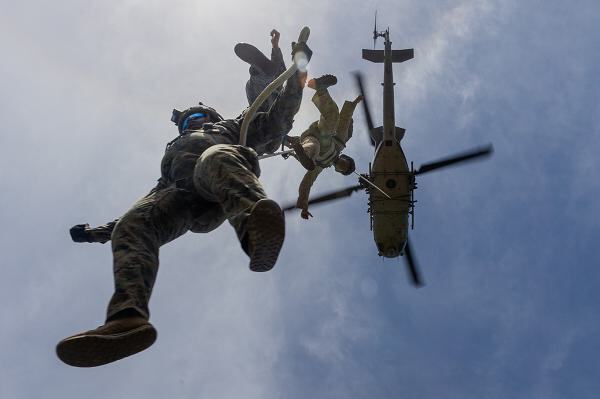
Okinawa, Japan. (October 2, 2024): America’s Special Forces go where they want to go and they get there in some amazing ways. In this photo by Corporal Kyle Chan, Marines with III MEF are extracted from the jungle by a UH-1Y Venom helicopter during helicopter rope suspension techniques (HRST) training. HRST is a set of techniques to insert/extract ground forces into or from difficult to reach terrain using helicopters. These methods include Rappelling, Fast roping, and Special Patrol Insertion/Extraction (SPIE) operations.
These methods were developed during the Vietnam War where helicopters were first used to insert small teams into the dense jungle or to retrieve troops from hostile situations. Today, special operators literally dive out of choppers using thick ropes to quickly drop to the ground. It is very much like leaping from an airplane and even more dangerous.
The first and most common insertion method is Rappelling which uses a seat harness connected to a D-ring to control the speed of the descent. This is a slow, but safer, method than the next choice, Fast roping.
Fast roping is like a firefighter sliding down a firehouse pole only using a thick rope that hangs down from the helicopter to the landing surface. The troops slide down the rope using their hands and without the safety harness used in Rappelling. That means any loss of concentration comes with the possibility of injury. The injuries one can sustain from fast-roping mishaps are similar to fall injuries resulting from parachute jump failure.
A safer method is the Special Patrol Insertion/Extraction (SPIE) system where multiple personnel, each wearing a harness, are transported as a “chain.” This technique is commonly used to rapidly insert or extract reconnaissance patrols from areas where a helicopter cannot. The helicopter lifts vertically until the rope and personnel are clear of obstructions and then proceeds to a secure insert zone. The rope and personnel are treated as an external load with airspeeds and altitudes monitored for safety.
America’s Special Operators can go anywhere they want because they have the daring and skills to do so.


